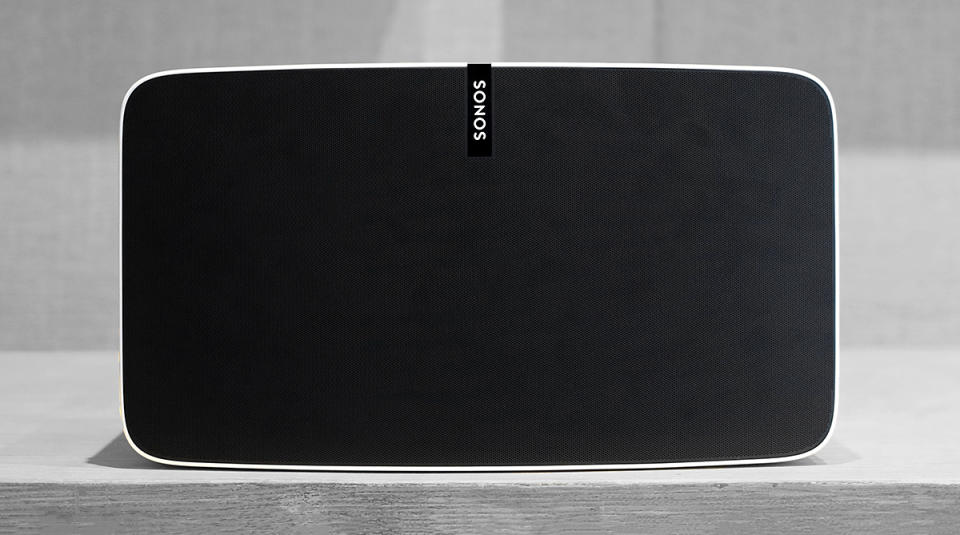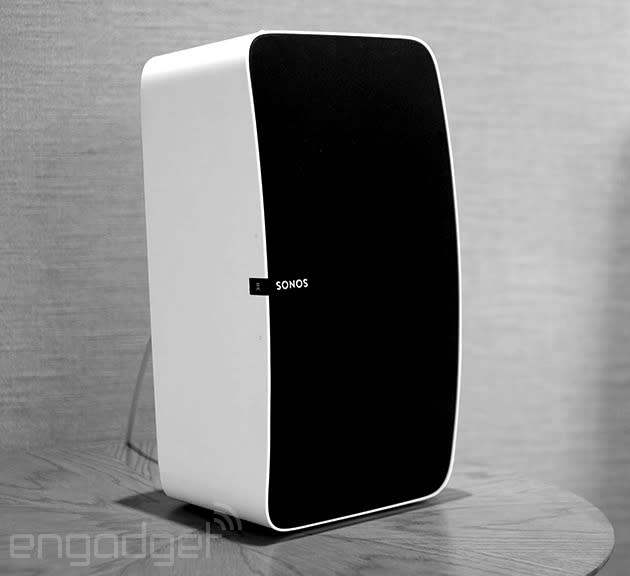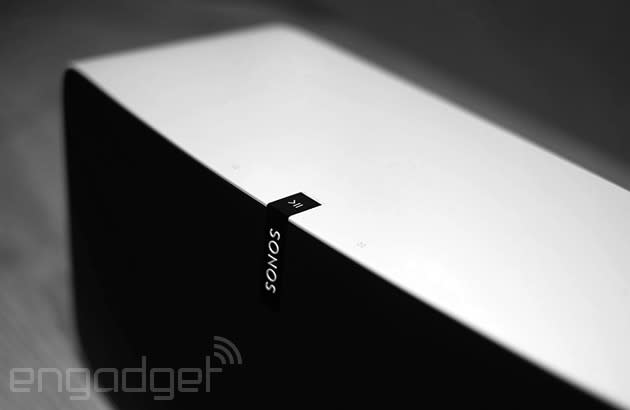The new Play:5 is Sonos' best speaker ever

The Sonos Play:5 is the wireless speaker that started it all. Sure, the Santa Barbara, California-based company had made products before it, but the Play:5 (known then as the S5) was its first all-in-one solution for home audio, and it was a hit. It's since been joined by a family of products, including the Play:3 and the diminutive Play:1. Now, Sonos has gone back to its beginnings, creating an all-new $499 speaker to replace its aging flagship. This is the Play:5. It's Sonos, reborn.
The first thing you'll notice about the new Sonos is the way it looks. The original isn't exactly an ugly piece of tech, but Sonos' design language has moved on since its 2009 release, and the old Play:5 now looks complicated when compared to the rest of the family. The new model has a similarly utilitarian casing to its more-recent speakers -- the first description that came to mind when I saw it was "elegantly oversized Play:3" -- but there are a few nice additions to the established formula here. The best is a new capacitive control panel, which relies on gestures and taps rather than physical buttons for controls. It sounds like a small change, but this enables three things. First, you get a cleaner, sleeker-looking speaker. Second, you can change tracks directly from your Sonos for the first time. Third, the controls are not orientation dependent. That means skipping tracks and turning the volume up or down work as you'd expect no matter the speaker's orientation.
The keen-eyed among you will have noted Sonos' switch to a new color scheme (black and white, rather than gray), which was first introduced with its Boost hub. This change makes a bigger difference than you'd imagine. The matte all-black version will fade into the background of any home, while the white-and-black edition is the polar opposite. The white is really white, and the black is really black, which creates a punchy contrast and makes the Play:5 a rather striking statement piece. There are also some really nice touches, such as the centered Sonos logo, which looks good in any orientation thanks to its palindromic nature, and simple, flush plastic grille.

Inside is a trio of mid-woofers, as well as a central tweeter and two side-firing tweeters. Around the back is a large, ink-filled Sonos logo, and a selection of ports that'll be familiar to existing users. There's a flush power cord, a 3.5mm line-in (the Play:5 remains the only Sonos product to have such an input), and a single Ethernet port. If you're looking to replace your existing Play:5, that might be an issue, as the original model has dual ports and acts as an Ethernet pass-through, but given the advances that Sonos has made with WiFi connections, it doesn't seem like a huge deal to me.
This is the first Sonos speaker that sounds more expensive than it is.
Okay, enough about the looks. How does it actually sound? Judging audio quality, at least by ear, is always going to be subjective, but I can safely say the Play:5 punches well above its pricing, with a balanced, crisp sound across the range. That's a high compliment, and something I've not been able to say about any Sonos before. Of course, all Sonos speakers sound good, but the reason I, and many others, have been willing to pay so much for the company's equipment is more to do with the software experience than audio quality. The Play:5 changes that, big time. I was able to pick out the sort of subtle details that get lost when I'm listening on the two Play:3s I use in my home office. I'm talking about quirks of track mastering and tonal shifts that I hear all the time when listening on my (very balanced) AKG K702 headphones, but typically get lost with cheaper equipment.
As mentioned, the Play:5 can be arranged in three orientations -- horizontally, or vertically on either side. When placed vertically, the pair delivers stereo audio that's more focused, while horizontally they create a wider "room-filling" range. Thanks to orientation sensors inside the speakers, the inside-facing tweeters are disabled when two speakers are paired horizontally, which prevents the channels from being muddled.
The new speaker array has a lot to do with that quality bump, but what's in front of it helps as well. The "simple" plastic grille I mentioned previously is in fact ridiculously intricate. There are some 60,000 individually drilled holes across its front, supported by a honeycomb structure that helps spread sound evenly beneath. Although you'd never know it, it's a big change from, for example, the Play:3's grille, which is simply a piece of plastic. Continuing the theme, even the solid-looking Sonos logo is deceptive -- there are hundreds of even smaller holes drilled in there that prevent the logo from blocking sound from the central tweeter.
The overall sound experience is aided by Trueplay, a new dynamic tuning system that's coming to the entire Sonos speaker range, minus the Playbar. You can read our full impressions on Trueplay in another article, but to briefly explain, it uses the microphones in an iOS device to calibrate the speakers automatically. The high concept is that you can put your speakers anywhere you like, and the Sonos controller app will adjust the power to various frequencies to compensate for the room's acoustic deficiencies. It's a simple system for an owner to set up, and helps balance the speakers considerably.

There are limits to what Trueplay can do, of course. One demo had a pair of speakers hidden behind heavy curtains, outputting some pretty horribly bassy and echoey audio. At the end of the Trueplay setup, the music was totally listenable, but some bass channels were very light. In less extreme examples, you'll get a better end result. One interesting thing about the Play:5 is a pair of microphones, which at launch will be deactivated. There's the potential they could be used to automatically tune the speakers with a future update, but whether that will happen is an unknown. It's interesting that Sonos is future-proofing its speakers in this way, even if it's unsure of the future that it's proofing against.
Stereo separation isn't perfect when you're listening to one speaker.
If I have one complaint about the Play:5, it's stereo separation. There's a new speaker alignment inside, which is supposed to create a far better single-speaker experience. The company's "sound experience leader" Giles Martin was keen to highlight the improved separation, but to me the channels just weren't far enough apart. To be clear, this is something all single-box "stereo" speakers suffer from, and Sonos' attempts here are definitely better than average. Perhaps I was looking for a miracle. Martin explained that they could artificially widen them farther, but it wouldn't sound natural. Instead of software trickery, the separation you hear from the Play:5 comes from the placement of the side-firing tweeters.
When you have two Play:5s configured as a stereo pair, though, the experience is jaw-dropping. At $998 for two, you'd expect them to, I guess, but the quality here is light-years ahead of anything Sonos has done before. I don't think we'll see music professionals using these in place of monitor speakers, but even audio enthusiasts are going to struggle to not be impressed with the quality on offer for what, at this price, are still "consumer-level" speakers.
Still, even a $499 speaker is a tough sell to most, let alone a $998 pair. It's likely that the new Play:5s will be more tempting to existing Sonos users (like me) who are looking to expand their system, rather than newcomers. That's probably not such a bad thing. At $199 the Play:1 is a great-sounding "budget" speaker that will win over a far larger crowd than this ever will. The Play:3 is a good mid-way option at $299, especially when you have two in a stereo-pair, and the Play:5 is the all-out option at $499.
With two Play:5s, you get very close to pro-level sound.
In fact, more than a product, the Play:5 is a statement of intent. It's Sonos saying it can compete with a "pro" setup for less than $1,000, and give you all the benefits of a WiFi music-streaming system at the same time. Although it falls a little short of that lofty goal, the Play:5 gets close enough that anyone looking to invest in a quality home audio setup owes it to themselves to check it out.












